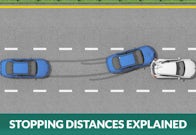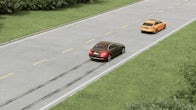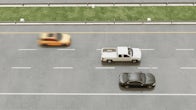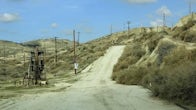

An important part of preventing a rear-end collision is knowing your stopping distance and how quickly your vehicle can come to a complete stop. Create a safety margin that gives sufficient distance between the vehicle in front so there is time to react and safely stop. In order to make a complete stop before a collision occurs, you must mentally calculate the stopping distance.
Knowing how speed affects the stopping distance is vital to being a safe driver. But first, let’s go through some important information.
Reaction distance is the distance your vehicle travels while you react. So the time it takes from the moment you see a hazard until you actually start braking. Reaction times vary from driver to driver.

Braking distance is the distance that it takes your vehicle to come to a full stop starting from the moment when you start applying the brake.

The braking distance is the distance it takes for your vehicle to come to a complete stop when you apply the brakes.
The stopping distance = reaction distance + braking distance. So the distance it takes for your vehicle to come to a complete stop from the moment you spot a hazard.
Speed makes a very big difference to your ability to stop in time and a significant difference to your chance of being involved in a crash:
Small increases in speed also affect stopping distance. Increasing your speed by just 10 mph from 50 mph to 60 mph increases the total stopping distance by up to 40%.

In general, double the speed increases the braking distance four times, and triple the speed increases the braking distance by nine times.
Wet and other slippery conditions along with dry, dirt roads also add a significant stopping distance to a full break. Stopping distance is affected by:


550+ exam-like questions
All you need to ace your test
Perfect for first-timers, renewals and senior citizens